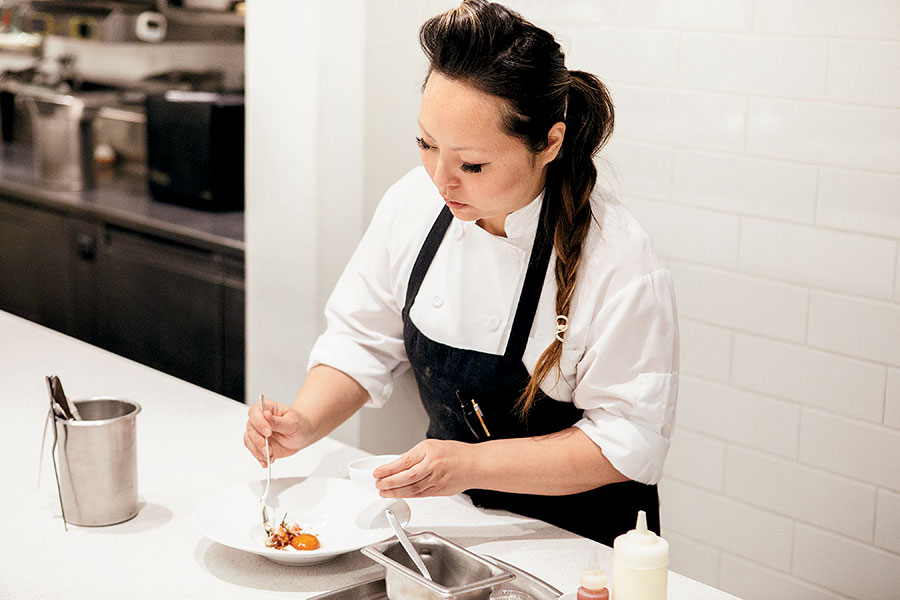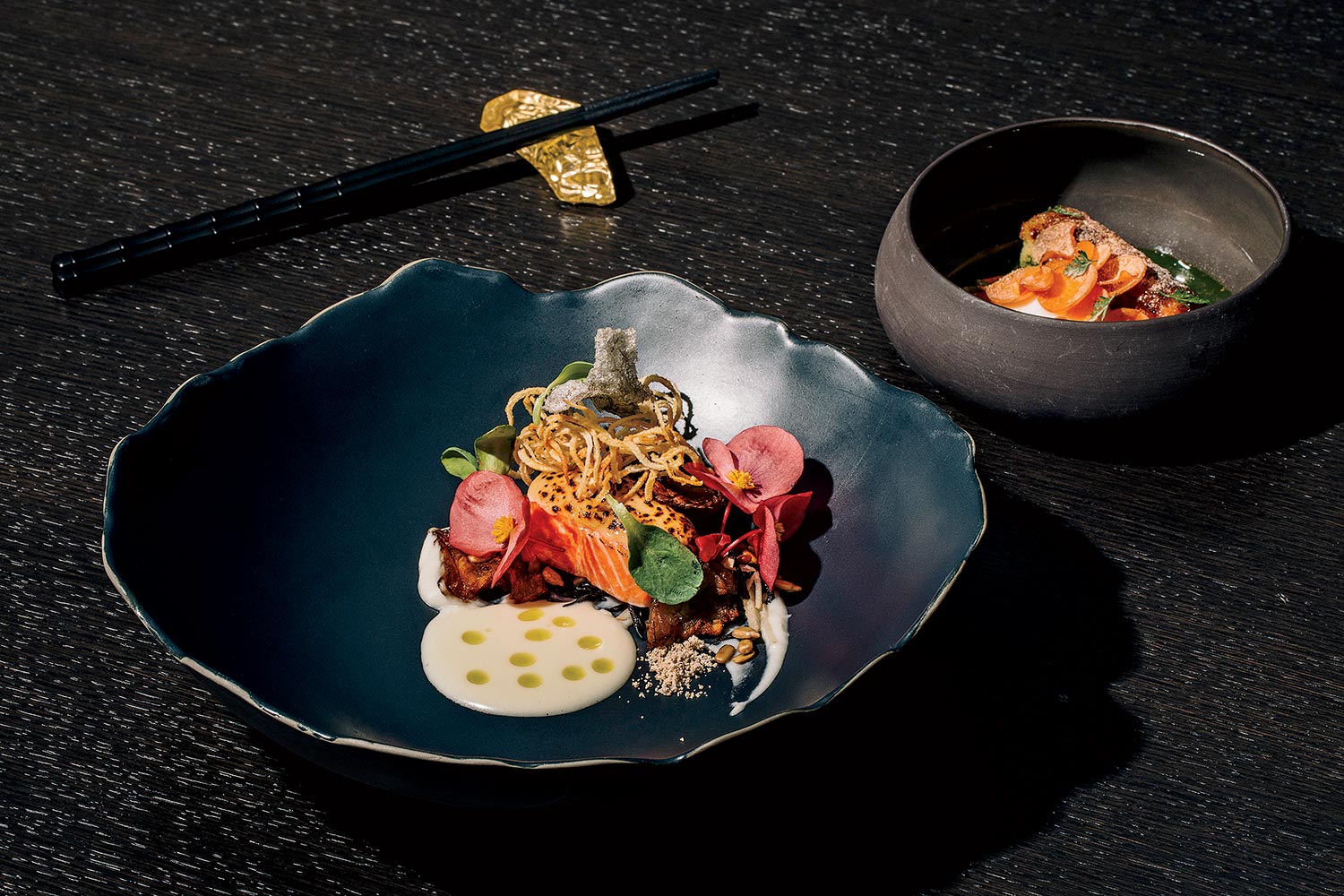"It feels like I’m cheating on Curtis,” announces my dining companion midway through our meal at Yugen. There’s a lot to unpack in those seven words, considering the companion is my wife, so I just say this: “Me too, honey.”
The specter of Curtis Duffy — who won three Michelin stars at 652 West Randolph Street as chef of Grace before his tenure ended in a walkout, a noncompete clause, and multiple lawsuits — haunts everything in this West Loop space. The restaurant was unforgettable, and so was Duffy’s intense presence. At various points I catch my wife casting furtive glances into Yugen’s glassed-in kitchen in search of a stray smolder from the guy. He’s been absent since 2017.
Yes, former Grace owner Michael Olszewski has regrouped with an impressive (and female-heavy) team, including Mari Katsumura (Blackbird), Jeanine Lamadieu (Smyth), and wine director Olivia Noren (Sepia). And yes, Crain’s reported that the room underwent a “mid-six-figure renovation.” But apart from the Rorschach-Zen art on the jewel-toned wall, it’s hard to tell where that money went. The space looks enough like it once did to induce déjà vu, and frankly, it’s impossible to view Yugen through any lens other than that of the Restaurant After Grace.
Yugen (the name’s a hard-to-translate Japanese term that means either “a deep awareness of the universe” or, ahem, “profound grace and subtlety”) isn’t Grace, nor should we expect it to be. But it’s a promising restaurant in its own right. Katsumura’s 12-course tasting menu ($205) uses Japan as a springboard while working within the traditional Western framework (canapés to start, mignardises to end, bread course somewhere in between). It begins with creative takes on familiar stuff, such as an almost fruity, consommé-like miso soup with puffed rice chips on life preservers of housemade tofu with pickled edamame, and a seaweed salad with a gently tempura-fried bluepoint oyster nestled among nasturtium and seaweed, which both have been fried and pickled.
The first hint of the kitchen’s potential is the crab rice course: Katsumura poaches Alaska king crab in smoked butter and cures a farm egg yolk overnight in tamari, then puts them together with puffed rice and furikake, ribbons of soy-dashi gel, deep-fried hen of the woods mushrooms, and a frothed uni sauce. It’s an intricate take on an afternoon snack from the chef’s childhood (she’d top some cooked rice, which her parents always had in the kitchen, with whatever she could find) and looks like the detritus from some found-art project. But pierce the yolk and the solution thickens into a rich, oceanic custard, the ideal foil for the crab. It’s a luscious mix of salt, fat, crunch, and pop.

Next comes a sashimi course that manages to honor the simple freshness of hiramasa (yellowtail) while surrounding it with a tableau more complicated than quantum physics. You’ve got smoking yuzu ice, bursting Okinawa sea grapes, and a sake broth made from the yellowtail’s binchotan-grilled bones and finished with Buddha’s hand syrup. This dish is revelatory: As the ice melts, the assemblage magically starts to resemble bubble tea.
This ability to stack flavors and push them to weird new frontiers peaks with the chawan mushi. Yugen’s version infuses Japan’s traditional savory egg custard with the flavor of uni, because why not, and it dangles a fried kombu chip over a ganache of Hudson Valley foie gras topped with black togarashi, Santa Barbara uni tongues, and Asian pear chips. Sweet melts into salty, and soft gives way to softer. When I asked the server where the lovely smoky undertone originates, she replied matter-of-factly, “Oh, that’s the smoked foie gras fat,” as if smoking the drippings of fattened duck liver was the most normal thing in the world.
The problem is that nothing that follows quite reaches these heights. A dish of aggressively overseasoned roast lamb and duck has none of the nuance or spark that preceded it. One dish — a shabu shabu of Miyazaki A5 wagyu — never came at all. With no printed menu at the meal’s start, I didn’t grasp this oversight until later, and believe me when I say that nothing leaves a worse taste in your mouth than Miyazaki wagyu you missed out on. The desserts are inventive (think compressed Japanese cheesecake brûléed on one side and topped with dill-seasoned compressed apples) but feel more like experiments than fully realized dishes.
For better or worse, Katsumura — who, as it happens, worked at Grace from 2012 to 2015 — and her team seem to understand what they’re up against. Despite the talent on hand, the whole operation appears to suffer from an eerie anxiousness. The meal moves at a breakneck speed, often with no breathing room between courses, as if the staff believes it’s being judged against an impossible standard and is terrified to lose your awe for even a moment. No restaurant can operate at that pace and intensity for long without cracks starting to show. More to the point, no restaurant that wants to be taken seriously should charge $200-plus for a prix fixe menu and forget to bring out the marquee course. At this level, that’s not a missed detail; it’s a massive blunder.
It’s not often that I get to say, “Wow, I’ve never had those flavors together before.” It’s even rarer that I want to experience such combinations again. At Yugen both those things happened repeatedly, and it may be worth a little awkwardness to experience that. But the best restaurants sell more than food. They sell comfort, pampering, and a promise that nothing has been overlooked. Yugen can’t keep that promise yet. I hope that time and familiarity will allow the staff to channel the ghosts of a much-missed Michelin-starred restaurant. And maybe, if the stars align, grace will follow.



